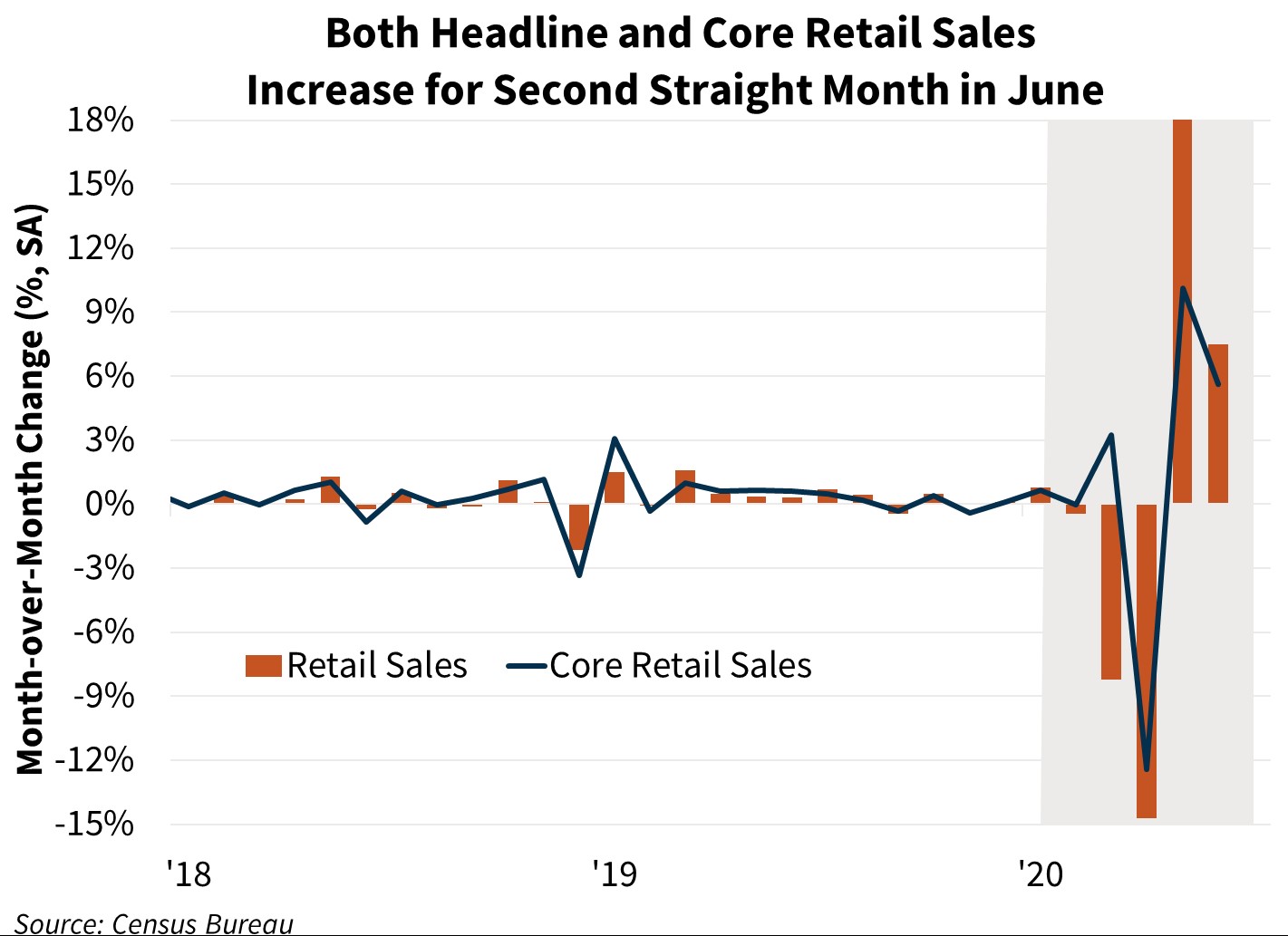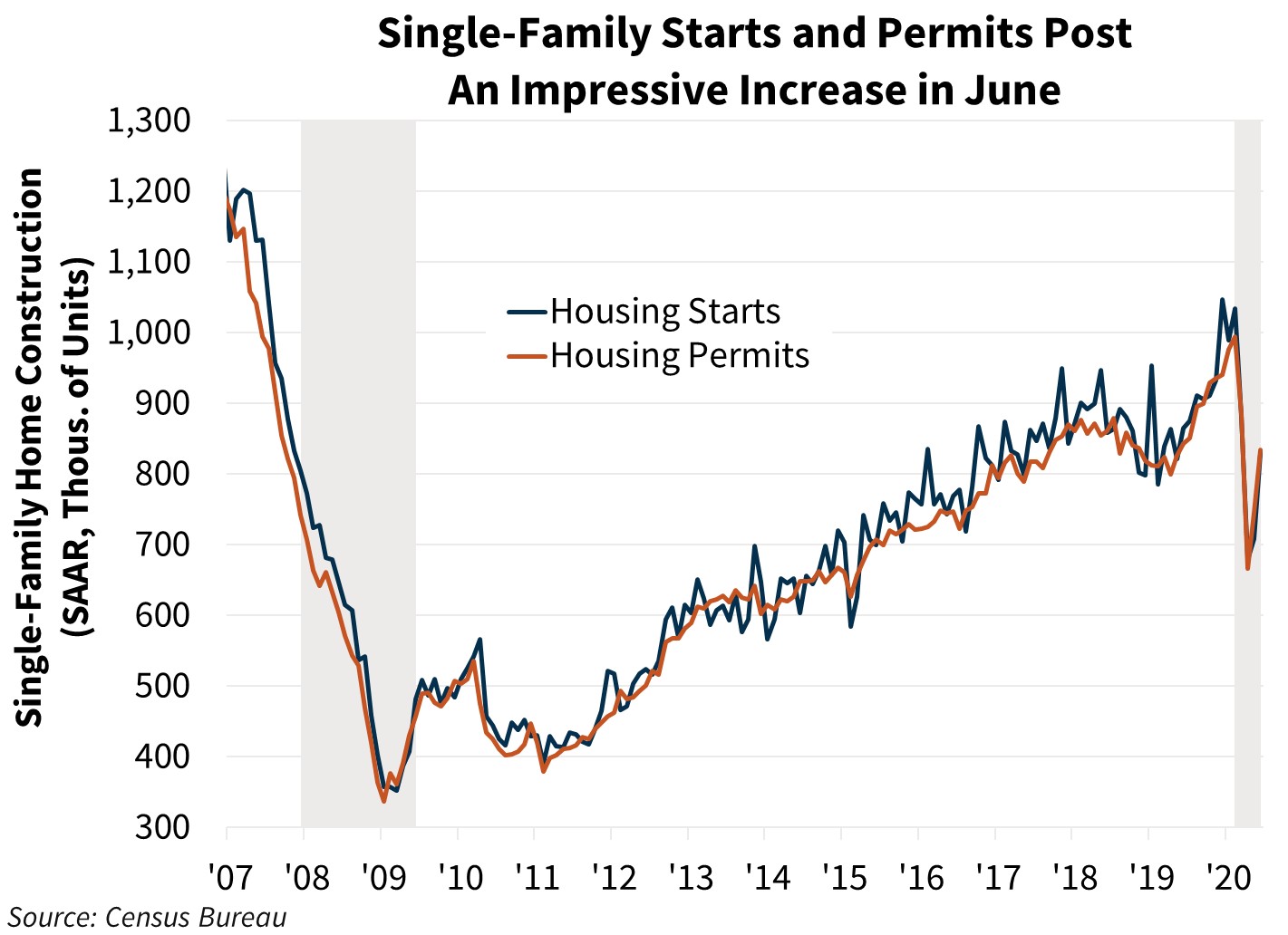June Data Paints a Picture of Recovery, but July Consumer Sentiment Highlights Downside Risks
Key Takeaways:
- Retail sales and food services jumped 7.5 percent in June, according to the Census Bureau, to just below February’s level. Sales at building supply stores remained elevated, sales at gas stations rose 15.3 percent, and food service sales climbed 20.0 percent. Core retail sales (excluding food services, auto, building supplies, and gas stations) increased 5.6 percent, driven by sales at clothing stores and furniture/appliance stores. Sales at nonstore retailers fell for the first time this year.
- Industrial production, a gauge of output in the manufacturing, utility, and mining sectors, increased 5.4 percent in June, according to the Federal Reserve Board. The increase was driven by manufacturing output, including a 105 percent increase in motor vehicle production. Output in the utilities sector increased, while mining output fell.
- Industrial production, a gauge of output in the manufacturing, utility, and mining sectors, increased 5.4 percent in June, according to the Federal Reserve Board. The increase was driven by manufacturing output, including a 105 percent increase in motor vehicle production. Output in the utilities sector increased, while mining output fell.
- The University of Michigan Consumer Sentiment Index fell 4.9 points to 73.2 in the preliminary July reading, just 1.4 points above the recent trough in April. Both the current economic conditions and consumer expectations indices fell, the latter declining 6.1 points to 66.2, only three-tenths above the May low.
- The Consumer Price Index (CPI) increased 0.6 percent in June, driven by a 5.1 percent increase in energy prices. Core CPI (which excludes food and energy) rose 0.2 percent. From a year ago, headline CPI rose 0.6 percent (the fastest pace since March) and core CPI increased 1.2 percent, the same pace as May.
- The National Federation of Independent Business (NFIB) Small Business Optimism Index rose 6.2 points in June to 100.6, the highest level since February. The share of firms reporting plans to increase employment rose eight percentage points to 16 percent, and the share of firms expecting the economy to improve rose to 39 percent, a level not seen since early 2018.
- Housing starts jumped 17.3 percent in June to a seasonally adjusted annualized rate (SAAR) of 1.19 million units, according to the Census Bureau. Single-family starts rose 17.2 percent to a SAAR of 831,000, while multifamily starts increased 17.6 percent to a SAAR of 355,000. The June increase in single-family starts was in line with our expectations, but with the upward revisions to the prior two months, the quarter averaged 740,000 units, down 23.6 percent from the first quarter, though slightly above our forecast of 722,000. Single-family permits increased 11.8 percent, while multifamily permits fell 13.4 percent. Year-to-date, single-family starts were down only 1.3 percent from the same period a year ago.
- The National Association of Home Builders/Wells Fargo Housing Market Index (HMI) rose 14 points in July to 72, the same level as March. Both indices for present sales and the sales outlook over the next six months increased. The index for the traffic of prospective buyers rose to tie its January level.
Forecast Impact
Economic data from June continued to point to a resurgence in economic activity as states began reopening. The increase in retail sales supports our expectation of a significant increase in second quarter consumer spending, though a large portion of the increase was driven by food services, which could see a reversal in activity now that many states are beginning to either slow or outright halt the reopening process due to the surge in new coronavirus cases. This risk is underscored by the drop in July consumer sentiment, which erased most of the gains seen since April. The outlook for business investment improved somewhat as industrial production posted the largest monthly increase since 1959, but like consumer spending, the recent rise in cases could dampen further improvements if businesses shut down again. In housing, given upward revisions to the prior month, both total and single-family starts averaged just above our expectations for the second quarter. While the strong increase in single-family permits and homebuilder sentiment suggest momentum for home construction heading into the third quarter, we believe the rise in building material costs to be a downside risk. Lumber prices spiked in mid-July, up over 40% from a month earlier.


Economic and Strategic Research Group
July 17, 2020
Opinions, analyses, estimates, forecasts and other views of Fannie Mae's Economic and Strategic Research (ESR) Group included in these materials should not be construed as indicating Fannie Mae's business prospects or expected results, are based on a number of assumptions, and are subject to change without notice. How this information affects Fannie Mae will depend on many factors. Although the ESR group bases its opinions, analyses, estimates, forecasts and other views on information it considers reliable, it does not guarantee that the information provided in these materials is accurate, current or suitable for any particular purpose. Changes in the assumptions or the information underlying these views, including assumptions about the duration and magnitude of shutdowns and social distancing, could produce materially different results. The analyses, opinions, estimates, forecasts and other views published by the ESR group represent the views of that group as of the date indicated and do not necessarily represent the views of Fannie Mae or its management.
